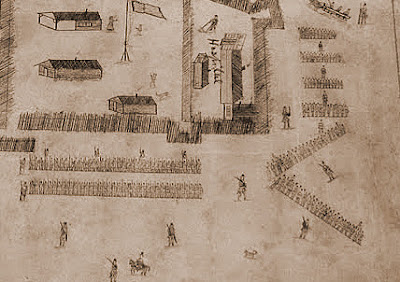 |
| 1862 Battle of Acton Map Photo By Brian Rogers |
An intricate drawing by Ernst D. Kirst— a cabinet maker, draftsman, enlisted soldier, and witness to the battle— captured the history of that battle in his detailed drawing. For so long it was a remnant almost forgotten. Found tattered, frail and in pieces, the picture has now been laborious restored and for the first time, shown to the public. It’s a drawing that dramatically portrays the story of the battle. It is a visual diary of the men who were part of it.
Alvah Getchell was 19 years old when he and other willing men followed Captain Richard Strout on a mission north of the Minnesota River Valley They were a small band and not well trained for battle. Just twenty enlisted soldiers went on that mission, while another 45 citizens joined in. Along the way the group would commandeer wagons and additional volunteers— as long as they had a horse.
While much of the history of the Dakota War has been focused the 1400 soldiers led by Colonel Sibley, this much smaller rag-tag band carried an equally important mission in the war—to protect the settlers in outlying areas from attack.
The men gathered what equipment they could at Fort Snelling and made their way on foot, knowing the dangers they could face on their mission. They went through Brooklyn Township, Monticello and finally to their destination of Glencoe. Finding the settlers they were supposed to protect there had already left, Strout decided to journey back to Forest City. Along the way the soldiers set up camp at the Jones farm, a site of previous murders in the Dakota War conflict.
 |
| Captain Stout Minnesota Historical Society photo |
The small group was struck with misfortune when they opened ammo boxes only to find a Quartermaster at Fort Snelling had mislabeled the ammunition. Despite feverishly trying to file down the musket balls to proper size, each of the men was left with only twenty rounds for daybreak.
When the group set out, they braced for the impending attack. The soldiers were quickly surrounded from all sides and outnumbered. Alvah Getchell was the first to die, a bullet piercing his brain and his body left on the battlefield. George Gidden was killed next, followed by Edwin Stone. Each man’s body, where they fell and name was painstakingly drafted into the now restored drawing.
 |
| Photo By Brian Rogers |
 |
| Photo By Brian Rogers |
Twenty others were wounded in the Battle of Acton, and three would die from their injuries. Jesse Branhum, one of the man who bravely volunteered to ride through the night to alert Strout, would be shot through the lung. He amazingly survived. The losses to the Dakota in the battle are not known.All these details are so graphically captured in Kirst’s drawing, from the placement of soldiers, to the paths taken and methods used. The intricate drawing made it through the decades and tells the story that was almost forgotten.
 |
| Photo by Brian Rogers |
.JPG) |
| Photo By D.Sannes |
*Story based on the Battle of Acton a presentation by Darryl Sannes of the Brooklyn Historical Society September 2012




No comments:
Post a Comment